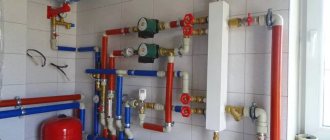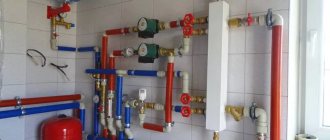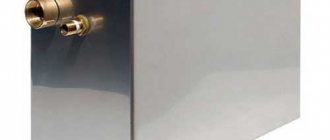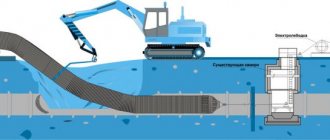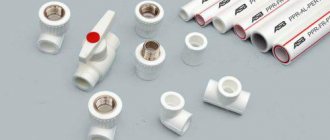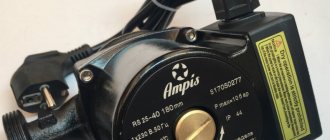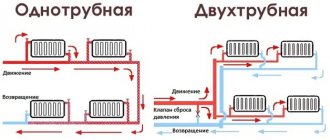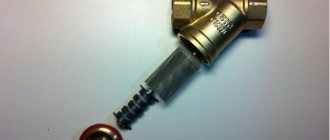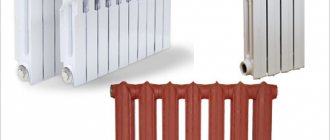Heating systems in their modern form are complex structures equipped with various equipment. Their efficient operation is accompanied by optimal balancing of all their constituent elements. The hydraulic arrow for heating is designed to provide balance. It’s worth understanding its operating principle, don’t you agree?
We will talk about how a hydraulic separator works and what advantages a heating circuit equipped with it has. The article we presented describes the installation and connection rules. Helpful operating instructions are provided.
What is a hydraulic arrow in a heating system, device and diagram
The design of the hydraulic arrow is extremely simple. This is a piece of rectangular or round pipe that has four outlets - two on the side of the boiler circuit and two on the consumer side. Such an element can be placed both horizontally and vertically. Although the second option is more common, since in this case it is easier to install an air vent and a tap to remove sludge that accumulates in the lower part of the structure.
Sectional diagram of a hydraulic arrow for heating systems
Some manufacturers install two meshes inside the hydraulic separator. One serves for air separation, and the other for sludge separation. Although most often such a product is completely empty, since during operation the grids become clogged quite quickly and lose their effectiveness.
A hydraulic arrow is installed at the break in the connection line between the boiler and the collector, dividing the coolant flow between consumers. Sometimes the hydraulic separator and manifold are assembled in one housing. This simplifies installation and makes the overall design more compact.
An example of a diagram for manufacturing a hydraulic arrow with a manifold in one housing
Calculation of hydraulic arrow
The hydraulic distributor is calculated using formula D to take into account the maximum mode according to the factory parameters of the boiler:
D = 3*d=1000* √ (4*Q)/(π *3600*ω)=18.8*√G/ ω,mm
Calculation of the diameter of the hydraulic valve taking into account the design thermal power of the boiler unit and the temperature difference between the forward and return lines:.
D = 3*d=1000* √ (4*P)/(π *C* ∆T*ω)=17.4*√G/(ω* ∆T), mm
Diameter of the hydraulic arrow pipe for incoming coolant:
d = √ (4*Q)/(π*V), mm
Where:
- D — D of the distributor body, mm;
- D — D of the inlet pipe, mm;
- P is the design heat output of the floor-standing boiler, kW;
- G is the highest coolant flow through the distributor, m3/hour;
- C—heat capacity of water, W/(kg*C);
- V is the speed of water through the CP, m/s;
- Q is the estimated hourly water consumption in KO, m3/h.
How to select parameters
The hydraulic separator is selected taking into account the maximum possible coolant flow rate. The fact is that at high speeds of liquid movement through the pipes, it begins to make noise. To avoid this effect, the maximum speed is assumed to be 0.2 m/s.
Parameters required for the hydraulic separator
By maximum coolant flow
To calculate the diameter of the hydraulic arrow using this method, the only thing you need to know is the maximum coolant flow that is possible in the system and the diameter of the pipes. With pipes everything is simple - you know which pipe you will use for wiring. We know the maximum flow that the boiler can provide (it is in the technical specifications), and the flow rate through the circuits depends on their size/volume and is determined when selecting circuit pumps. The flow rate for all circuits is added up and compared with the power of the boiler pump. A large value is substituted into the formula to calculate the volume of the hydraulic needle.
Formula for calculating the diameter of a hydraulic separator for a heating system depending on the maximum coolant flow
Let's give an example. Let the maximum flow rate in the system be 7.6 cubic meters/hour. The permissible maximum speed is taken as standard - 0.2 m/s, the diameter of the pipes is 6.3 cm (2.5 inch pipes). In this case we get: 18.9 * √ 7.6/0.2 = 18.9 * √38 = 18.9 * 6.16 = 116.424 mm. If we round, we find that the diameter of the hydraulic needle should be 116 mm.
According to the maximum boiler power
The second method is to select a hydraulic needle according to the boiler power. The estimate will be approximate, but it can be trusted. The boiler power and the difference in coolant temperatures in the supply and return pipelines will be needed.
Calculation of hydraulic arrow according to boiler power
The calculation is also simple. Let the maximum boiler power be 50 kW, the temperature delta be 10°C, the diameters of the pipes be the same - 6.3 cm. Substituting the numbers, we get - 18.9 * √ 50 / 0.2 * 10 = 18.9 * √ 25 = 18.9*5 = 94.5 mm. Rounding, we get the diameter of the hydraulic needle 95 mm.
How to find the length of the hydraulic arrow
We have decided on the diameter of the hydraulic separator for heating, but we also need to know the length. It is selected depending on the diameter of the connected pipes. There are two types of hydraulic arrows for heating - with taps located one opposite the other and with alternating pipes (located offset from one another).
Determining the length of the hydraulic arrow from a round pipe
It is easy to calculate the length in this case - in the first case it is 12d, in the second - 13d. For medium-sized systems, you can select the diameter depending on the pipes - 3*d. As you can see, nothing complicated. You can calculate it yourself.
Purchased models
A typical example is the Sever-M5 collector. It works in heating systems with a power of up to 70 kW. The cost of the unit is about 9.5 thousand rubles.
A hydraulic arrow in a heating system is a hydraulic distribution device designed to distribute coolant over several circuits. Its installation is recommended in cases where the power of the boiler used is over 50 kW. The arrow is also used in complex branched systems with many secondary circuits - it is needed for balancing. You can buy it or assemble it yourself.
The easiest way is to buy a hydraulic gun in a ready-made factory version. The simplest model, for example, SINTEK ST-35, will cost 2,700 rubles if you buy it directly from the manufacturer. It can withstand pressure up to 6 bar and can be installed in heating systems with a heating power of up to 35 kW.
A heating manifold with a hydraulic arrow for 5 circuits is designed for the branched systems mentioned above. You can connect an indirect heating boiler to it, heated floors in the bathroom, kitchen and hallway, as well as three main circuits - on the ground floor, in the basement, and in the attic.
Other store equipment:
- Hydraulic arrow WOODSTOKE 331 – for heating with a power of up to 70 kW for 7 circuits. The cost of the device is 11 thousand rubles.
- Warme WGR 80 is a simple hydraulic valve with two pipes and two outlets for connecting an air vent and a tap. Cost – 4000 rubles. The model can operate in heating systems with a power of up to 80 kW.
- Proxotherm GS 32-1 - hydraulic needle is made in a shiny case, as it is made of stainless steel. It is designed to work in heating systems with a power of up to 85 kW. Cost - about 7-8 thousand rubles.
- Gidruss BM is a whole series of hydraulic arrows for heating systems with a power from 60 to 150 kW. They are made of high-quality structural steel and can withstand pressures of up to 6 bar at temperatures up to +110 degrees. The cost varies from 9 to 30 thousand rubles.
There are thousands of ready-made hydraulic guns, there is plenty to choose from.
The advantages of magazine-operated hydraulic shooters are quite obvious. First of all, they are characterized by impeccable build quality. The equipment must withstand significant pressure - up to 3-4 atmospheres for autonomous heating and up to 20-25 atmospheres for general heating. It is made from proven grades of steel created for the construction of heating equipment and other systems.
Secondly, the factory water guns are already designed for use in heating systems with one or another power. They have been verified many times, so their use will not cause any accidents. The stores will also offer auxiliary equipment for the installation of heating systems. And then there will be no problems with the warranty on boilers and radiators.
Why do you need a hydraulic arrow: principle of operation, purpose and calculations
During the operation of an individual heating system, problems arise related to the discrepancy between the volume of consumption and the performance of the boiler. In some modes, it is possible to receive signals from temperature sensors, which will increase the power to maximum values. With simultaneous insufficient media consumption by the secondary circuit, the thermal load will increase excessively. Such situations increase the likelihood of accidents.
In case of breakdowns, you will need the help of specialists
To describe another situation, it is necessary to assume that the boiler capacity established by the technical passport is 50 l/min. despite the fact that it is necessary to connect heating radiators with twice the consumption. It will not be possible to increase the power so much without placing excessive loads on the equipment.
The next problem is the mutual influence of different types of consumers (warm floors, external boiler, several groups of radiators). For their normal functioning, different volumes and temperatures of coolant are required.
Such problems can be solved using additional sensors and settings. But this will lead to a significant complication of the design and a decrease in the overall level of reliability. In practice, experienced specialists recommend using an elegant engineering solution, which is discussed in detail in this article.
Operating principles of hydraulic arrows in heating systems and main functions
The main purpose of this device is to limit, and ideally, eliminate the hydrodynamic influence of different circuits in the heating system on each other. To do this, use special containers that are inserted into the gap between the two circuits.
Typical hydraulic arrows in the shape of a cylinder and cube in section
This picture schematically shows a set of equipment with two pumps and connected radiators.
Dual circuit system
Here Q1 and Q2 are the water flow rates in each circuit. If these values are equal, the fluid moves along a common complete contour, as shown in the figure below.
Standard movement along a common contour
The following shows how the passage of fluid changes when the balance in consumption is disturbed:
Return flow is greater than supply
Supply flow is greater than return flow
In order to obtain a hydraulic gun that performs its functions efficiently, the principle of operation, purpose and calculations are coordinated in a special way. It is necessary to create the last option with slow movement of water inside the device from top to bottom. Experts recommend limiting the speed of this process to 0.09-0.12 m/sec. This will help solve the following problems:
- Under such conditions, mechanical impurities will gradually settle at the bottom of the container. If you equip it with a special device, a collector, it will be possible to clean the system during routine maintenance.
- A slow speed will allow the hydraulic arrow to be used to withdraw fluid into other circuits with different temperature gradients.
- It is also useful for accumulating gas bubbles in the upper part of the body. There you can install an automatic air removal device.
Scheme of using a hydraulic arrow in a complex heating system
Hydraulic heating device
The next picture shows a standard product in this category.
The valve installed at the bottom is designed to drain liquid along with mechanical impurities
Note the special narrowing at the bottom. Contaminants accumulate in it and are not carried further into the system by the flow of liquid. An automatic air release valve is mounted on top
There is an automatic valve mounted on top that releases air.
If necessary, hydraulic arrows are equipped with pressure gauges, valves and other devices
How is a hydraulic arrow useful?
The need to use the classic hydraulic separator design is obvious. Moreover, on systems with boilers, the implementation of this element becomes a mandatory action.
Installing a hydraulic valve in the system served by the boiler ensures stable flows (coolant flow). As a result, the risk of water hammer and temperature surges is completely eliminated.
Examples of hydraulic arrows in a classic simple design based on plastic pipelines. Now such structures can be found even more often than metal ones. The operating efficiency is almost the same as that of metal ones, but the fact of savings on the device and implementation in the system
For any conventional water heating system made without a hydraulic separator, turning off part of the lines is inevitably accompanied by a sharp rise in the temperature of the boiler circuit due to low flow. At the same time, the highly cooled return flow takes place.
There is a risk of water hammer formation. Such phenomena are fraught with rapid failure of the boiler and significantly reduce the service life of the equipment.
In most cases, plastic structures are well suited for household systems. This application option seems to be more economical to install.
In addition, the use of fittings makes it possible to install a system of polymer pipes and connect plastic hydraulic arrows without welding. From a maintenance point of view, such solutions are also welcome, since the hydraulic separator installed on the fittings can be easily removed at any time.
Why do you need a hydraulic arrow: principle of operation, purpose and calculations
Many heating systems in private households are unbalanced. The hydraulic arrow allows you to separate the circuit of the heating unit and the secondary circuit of the heating system. This improves the quality and reliability of the system.
Features of the device
When choosing a hydraulic gun, you need to carefully study the principle of operation, purpose and calculations, and also find out the advantages of the device:
- the separator is necessary to ensure that the technical specifications are met;
- the device maintains temperature and hydraulic balance;
- parallel connection ensures minimal losses of thermal energy, productivity and pressure;
- protects the boiler from thermal shock and also equalizes circulation in the circuits;
- allows you to save fuel and electricity;
- a constant volume of water is maintained;
- reduces hydraulic resistance.
Operation of the device with a four-way mixer
The operating features of the hydraulic switch make it possible to normalize hydrodynamic processes in the system.
Helpful information! Timely removal of impurities allows you to extend the service life of meters, heating devices and valves.
Hydraulic heating device
Before you buy a hydraulic arrow for heating, you need to understand the structure of the structure.
Internal structure of modern equipment
The hydraulic separator is a vertical vessel made of large diameter pipes with special plugs at the ends. The dimensions of the structure depend on the length and volume of the circuits, as well as on the power. In this case, the metal case is installed on support posts, and small-sized products are mounted on brackets.
Connection to the heating pipeline is made using threads and flanges. The material used for the hydraulic arrow is stainless steel, copper or polypropylene. In this case, the body is treated with an anti-corrosion substance.
Note! Polymer products are used in a system with a boiler with a capacity of 14-35 kW. Making such a device with your own hands requires professional skills.
Additional equipment functions
The principle of operation, purpose and calculations of the hydraulic arrow can be learned and performed independently. The new models have the functions of a separator, separator and temperature regulator. A temperature control valve provides a temperature gradient for the secondary circuits. Removing oxygen from the coolant reduces the risk of erosion of the internal surfaces of equipment. Removing excess particles increases impeller life.
Inside the device there are perforated partitions that divide the internal volume in half. This does not create additional resistance.
The diagram shows a sectional view of the device
Helpful information! Complex equipment requires a temperature sensor, a pressure gauge and a line to power the system.
The principle of operation of a hydraulic arrow in heating systems
The choice of hydraulic arrow depends on the speed of the coolant. In this case, the buffer zone separates the heating circuit and the heating boiler.
There are the following hydraulic arrow connection diagrams:
neutral operating scheme, in which all parameters correspond to the calculated values. At the same time, the design has sufficient total power;
Using a heated floor circuit
a certain scheme is used if the boiler does not have sufficient power. If there is insufficient flow, an admixture of cooled coolant is required. When there is a temperature difference, thermal sensors are triggered;
Heating system diagram
the flow volume in the primary circuit is greater than the coolant consumption in the secondary circuit. In this case, the heating unit operates in optimal mode. When the pumps in the second circuit are turned off, the coolant moves through the hydraulic valve along the first circuit.
Option for using a hydraulic arrow
The performance of the circulation pump should be 10% greater than the pressure of the pumps in the secondary circuit.
Features of the system
This table shows some models and their prices.
Requirements for the furnace
When installing a pair of units of the same type, the requirements for the boiler room apply to a specific type of energy carrier: electric, gas, coal, wood.
When choosing boilers that consume different types of fuel, the premises must comply with the standards for both heaters; the maximum parameter is finally accepted. It usually refers to solid fuel devices.
Requirements for devices operating on solid fuel:
- the minimum floor area is assigned according to the total thermal output of the boilers (from 7.5 to 15 m²);
- a heater with a power of over 30 kW is located in the center of the boiler room to ensure free air circulation;
- walls, partitions, floors, ceilings of the room are finished with fire-resistant materials using waterproofing;
- the boiler is mounted on a base made of non-combustible materials;
- for heaters with a power of less than 30 kW, there are no increased requirements for fire resistance of the floor; it can be covered with sheet steel;
- solid fuel must be stored in a special room; a daily supply is allowed, but at a distance of more than 1 m from the boiler;
- the furnace room must have windows and a door that provide three times the air circulation rate based on the volume of the furnace room.
An example of a boiler room layout on the first floor
The following requirements apply to gas-fired heating units:
- boilers with a total power of up to 30 kW can be located in a separate non-residential premises with a door and windows that provide threefold air circulation;
- with a total boiler power of more than 30 kW, it is necessary to allocate a separate room with an area of at least 7.5 m² and a ceiling height of 2.5 m;
- if a gas appliance is installed in a kitchen with a gas stove, the area of the room is taken to be at least 15 m².
Operating principle and purpose of the hydraulic gun
- The hydraulic arrow is necessary for hydrodynamic balancing of the heating system and serves as an additional unit. It makes it possible to protect boiler heat exchangers made of cast iron from possible thermal shocks. This can happen during the initial start-up of the boiler, technical checks or maintenance work, which are accompanied by the mandatory shutdown of the heating and hot water supply circulation pump. Also, the use of a hydraulic arrow will protect the integrity of your heating system in the event of automatic shutdown of hot water circuits, underfloor heating, etc. When installing a heating system in your home, in order to comply with the manufacturer’s warranty on the equipment, the installation of a hydraulic arrow is a prerequisite. These requirements are mandatory for boilers whose heat exchanger is made of cast iron. Since, if a large temperature difference occurs between the water at the outlet and the inlet, the destruction of cast iron is possible due to its natural fragility.
- To equalize pressure at unequal flow rates in the main boiler circuit and the total consumption of secondary heat circuits. The hydraulic separator will be useful in the case of multi-circuit heating systems (heating radiators, water heater, hot flooring, etc.). By observing hydrodynamic standards, our device makes it possible to 100% eliminate the influence of circuits on each other and guarantee their uninterrupted operation in specified modes.
- With the correct calculation of the dimensions and hydromechanical parameters, the hydraulic arrow will act as a sump and remove mechanical formations such as rust, sludge, and scale from the coolant. This will significantly extend the operating time of all moving and rubbing elements of the heating system, such as pumps, shut-off valves, meters and sensors.
- The hydraulic separator performs the important role of removing air from the coolant. This will significantly reduce the amount of oxidized metal parts of the heating system.
Manufacturing schemes
Industrially manufactured water guns are not cheap and many people make them with their own hands. In this case, you need to make preliminary calculations. The main design dimensions are shown in the figure below.
Hydraulic switch diagram with main design dimensions
As can be seen from the figure, the diameter of the hydraulic needle itself is taken equal to three diameters of the inlet pipes, so the calculations come down mainly to determining the diameter of the hydraulic needle.
The figure shows two options for hydraulic arrows. The purpose of the second option is better than the first in that when the water passes through the supply pipeline, it is freed from air bubbles, and when it flows back, it better gets rid of sludge.
The calculation comes down mainly to determining the diameter of the hydraulic needle:
Where:
- D – diameter of the hydraulic needle in mm;
- d is the diameter of the inlet pipe in mm, usually taken equal to D/3;
- 1000 – conversion factor meters to mm;
- P – boiler power in kJ;
- π – pi number = 3.14;
- C – heat capacity of the coolant (water – 4.183 kJ/kg C°);
- W – maximum vertical speed of water movement in the hydraulic arrow, m/s, usually taken equal to 0.1 m/s;
- ΔT – difference in coolant temperatures at the inlet and outlet of the boiler, C°.
The calculation can also be performed using the following formula:
Where:
- Q – coolant flow, m³/s;
- V – speed of water movement in the hydraulic arrow, m/s;
There is also the following formula to calculate the diameter of the hydraulic needle:
Where:
- G – flow rate, m³/hour;
- W – water speed, m/s;
The height of the hydraulic arrow can be any and is limited only by the height of the ceiling in the room.
If you make the diameter of the hydraulic arrow large enough, you can get two in one: a hydraulic arrow and a heat accumulator, the so-called capacitive separator.
Diagram of a capacitive separator in a heating system
As can be seen from the figure, a hydraulic arrow of this type has a large volume, about 300 liters or more, therefore, in addition to performing its main task, it is also capable of accumulating heat. The use of a hydraulic arrow of this type is especially justified when heating with a solid fuel boiler, as it can smooth out temperature fluctuations in the heating boiler and retain the thermal energy of the boiler after the end of combustion for quite a long time.
You need to know some nuances when using this type of hydraulic arrow:
- Firstly, such a hydraulic arrow must be insulated, since otherwise it will heat the boiler room and not transfer heat to the heating system.
- The boiler will produce less power. This is explained by the fact that a high coolant temperature is required, and the boilers are equipped with automatic equipment that will automatically reduce its power to reduce the outlet temperature.
Popular manufacturers
There are not as few companies involved in the production of hydraulic separators for heating networks as it might seem at first glance. However, today we will get acquainted with the products of only two companies, GIDRUSS and Atom LLC, since they are considered the most popular.
Table. Characteristics of hydraulic separators manufactured by GIDRUSS.
| 1. GR-40-20 | — the product is made of structural steel; — designed for one consumer; — minimum power of the heating device is 1 kilowatt; — its maximum power is 40 kilowatts. |
| 2. GR-60-25 | — the product is made of structural steel; — designed for one consumer; — the minimum power of the heating device is 10 kilowatts; — its maximum power is 60 kilowatts. |
| 3. GR-100-32 | — the product is made of structural steel; — designed for one consumer; — minimum power of the heating device is 41 kilowatts; — its maximum power is 100 kilowatts. |
| 4. GR-150-40 | — the product is made of structural steel; — designed for one consumer; — minimum power of the heating device is 61 kilowatts; — its maximum power is 150 kilowatts. |
| 5. GR-250-50 | — the product is made of structural steel; — designed for one consumer; — the minimum power of the heating device is 101 kilowatts; — its maximum power is 250 kilowatts. |
| 6. GR-300-65 | — the product is made of structural steel; — designed for one consumer; — minimum power of the heating device is 151 kilowatts; — its maximum power is 300 kilowatts. |
| 7. GR-400-65 | — the product is made of structural steel; — designed for one consumer; — minimum power of the heating device is 151 kilowatts; — its maximum power is 400 kilowatts. |
| 8. GR-600-80 | — the product is made of structural steel; — designed for one consumer; — minimum power of the heating device is 251 kilowatts; — its maximum power is 600 kilowatts. |
| 9. GR-1000-100 | — the product is made of structural steel; — designed for one consumer; — minimum power of the heating device is 401 kilowatts; — its maximum power is 1000 kilowatts. |
| 10.GR-2000-150 | — the product is made of structural steel; — designed for one consumer; — minimum power of the heating device is 601 kilowatts; — its maximum power is 2000 kilowatts. |
| 11. GRSS-40-20 | — the product is made of AISI 304 stainless steel; — designed for one consumer; — minimum power of the heating device is 1 kilowatt; — its maximum power is 40 kilowatts. |
| 12. GRSS-60-25 | — the product is made of AISI 304 stainless steel; — designed for one consumer; — the minimum power of the heating device is 11 kilowatts; — its maximum power is 60 kilowatts. |
| 13. GRSS-100-32 | — the product is made of AISI 304 stainless steel; — designed for one consumer; — minimum power of the heating device is 41 kilowatts; — its maximum power is 100 kilowatts. |
What is the principle of operation of a hydraulic arrow in a heating system?
The hydraulic arrow can be designated as an intermediary between the boiler or stove and the entire heating system. The operation of the hydraulic separator is as follows:
- The coolant enters the hydraulic separator, changing direction and speed. This is necessary to create a movement in which the hot flow goes up and the cold flow goes down. In turn, this process creates a thermal separation within the water gun for all circuits connected to it. For example, boilers have a high temperature, heated floors have a low temperature, and boilers are characterized by average values of this indicator.
- A high-temperature coolant entering the hydraulic arrow reduces the rate of heat distribution. This leads to the release of air, which must be removed from the heating system using a special valve located at the top of the device. It can be either manual or automatic. A Mayevsky tap is usually used as a manual valve (also called a mechanical valve). In some models, a hydraulic arrow for complex heating systems is installed at the bottom of a faucet to remove dirt and debris.
The hydraulic arrow has three operating modes:
Mode 1
In this mode, the heating system works flawlessly. The coolant pressure generated by the pump in the smaller circuit is equal to the total pressure in the remaining circuits of the system. The inlet and outlet temperatures have the same values. The working fluid either does not move vertically at all, or this movement is minimal.
However, as practice shows, ideal work situations are extremely rare. As noted above, the functioning of heating circuits is prone to fluctuations and changes.
Mode 2
In a smaller circuit, the fluid flow is not as high as in the heating circuit. In this case, demand exceeds supply, which leads to the formation of a vertical flow from the return pipe to the supply pipe. During its rise, this flow mixes with hot liquid coming from the heating device.
Mode 3
The situation is absolutely the opposite of mode 2. In this case, the coolant flow in the heating circuits is less than this figure in the small circuit. This happens for several reasons:
- A short shutdown of one or more circuits due to the lack of need for heating any room;
- During the heating process of the boiler, when all circuits are connected in turn;
- Repair of one of the circuits in which this element is disabled.
These situations are not critical, since a downward flow of a vertical direction is formed in the hydraulic arrow.
Is it possible to install one pump per circuit?
It would seem quite logical to equip each heating circuit with its own circulation pump that meets all the necessary parameters in order to solve the problem. Is it so? Unfortunately, even in this case the problem will not be solved - it will simply move to another level! Indeed, for the stable functioning of such a system, an accurate calculation of each pump is necessary, but even with this, a complex multi-circuit system will not become equilibrium. Each pump here will be associated with its own circuit, and its characteristics will change (that is, they will not be stable). In this case, one of the circuits can fully operate, and the second can be turned off. Due to circulation in one circuit, inertial movement of the working fluid may occur in an adjacent circuit, where this is not required at all (at least for the moment). And there can be a lot of such examples.
Operating principle of the hydraulic separator
The first thing you need to understand is what a hydraulic arrow is in a heating system as a separate element. Structurally, the hydraulic arrow is a hollow device in the form of a pipe with a square cross-section of the profile (read: “The principle of operation and design of the heating hydraulic arrow, purpose”). The simplicity of the design suggests that the operating principle of such a device is quite simple. Thanks to the hydraulic arrow, air is first released and removed from the system, for which an automatic air vent is used.
The heating system is divided into two circuits - large and small. The small circle includes the hydraulic needle itself and the boiler, and in the large circle the consumer is also added to these elements. When the boiler produces the optimal amount of heat, which is completely consumed for heating, the coolant in the hydraulic arrow moves only in the horizontal plane. If the balance of heat and its consumption is disturbed, the coolant remains within the small circuit, and the temperature in front of the boiler rises.
All these actions lead to automatic shutdown of the system, but the coolant continues to move quietly in the small circuit - and so on until its temperature drops to the required value. Upon reaching the set point, the boiler resumes operation in normal mode. All this answers the question of why a hydraulic arrow is needed for heating - it ensures the independent operation of all circuits.
In what cases are two boilers installed?
The decision on the need to install a second device is made when the existing one cannot cope with the required heat load. The added boiler eliminates the lack of equipment power.
Installation diagram of a pair of boilers
There are other indications for simultaneously connecting two boilers to the heating system:
- errors in determining the thermal power of boiler installations;
- expanding the area of the house to be heated;
- increasing the capabilities of the heating source;
- limited volume of main fuel.
Hydraulic flow separation
The hydraulic arrow for heating is more often called a hydraulic separator. From this it becomes clear that this system is intended for implementation in heating circuits.
In heating, it is assumed that several circuits are used, for example, such as:
- lines with groups of radiators;
- underfloor heating system;
- hot water supply through a boiler.
In the absence of a hydraulic arrow for such a heating system, you will either have to make a carefully calculated design for each circuit, or equip each circuit with an individual circulation pump.
But even in these cases there is no complete certainty of achieving the optimal balance.
The classic design of hydraulic separators made on the basis of round or rectangular pipes can be considered approximately this way. A simple but effective solution that radically changes the state of the heating system involving the boiler
Meanwhile, the problem is solved simply. You just need to use a hydraulic separator in the circuit - a hydraulic arrow. Thus, all circuits included in the system will be optimally separated without the risk of hydraulic losses in each of them.
Hydroarrow – the name is “everyday”. The correct name corresponds to the definition – “hydraulic separator”. From a constructive point of view, the device looks like a piece of an ordinary hollow pipe (round, rectangular cross-section).
Both end sections of the pipe are plugged with metal plates, and on different sides of the body there are inlet/outlet pipes (a pair on each side).
The natural appearance of the products is hydraulic switches made from rectangular and round pipes. Both options show high efficiency. However, hydraulic guns based on round pipes are still considered a more preferable option
Traditionally, the completion of installation work on the heating system is the beginning of the next process - testing. The created plumbing design is filled with water (T = 5 – 15°C), after which the heating boiler is started.
Until the coolant is heated to the required temperature (set by the boiler program), the water flow is “spinned” by the primary circuit circulation pump. Circulation pumps of secondary circuits are not connected. The coolant is directed along the hydraulic arrow from the hot side to the cold side (Q1 > Q2).
If the coolant reaches the set temperature, the secondary circuits of the heating system are activated. The coolant flows of the main and secondary circuits are equalized. In such conditions, the hydraulic arrow functions only as a filter and air vent (Q1 = Q2).
Functional diagram of the operation of a classic hydraulic switch for three different boiler operating modes. The diagram clearly indicates the distribution of heat flows for each individual operating mode of boiler equipment
If any part (for example, a heated floor circuit) of the heating system reaches a predetermined heating point, the selection of coolant by the secondary circuit temporarily stops. The circulation pump is turned off automatically, and the water flow is directed through the hydraulic arrow from the cold side to the hot side (Q1 < Q2).
Types of separators
Classification of separators:
- Depending on volume:
- large – 200-300 l.;
- medium - from 20 to 150 liters;
- small - less than 20 liters.
- Depending on the number of circuits:
- double-circuit;
- multi-circuit.
- Depending on the section shape:
- round;
- square.
- Depending on location:
- horizontal;
- at an angle;
- vertical.
- Depending on the position of the pipes:
- parallel (on the same axis);
- alternating (on different axes).
